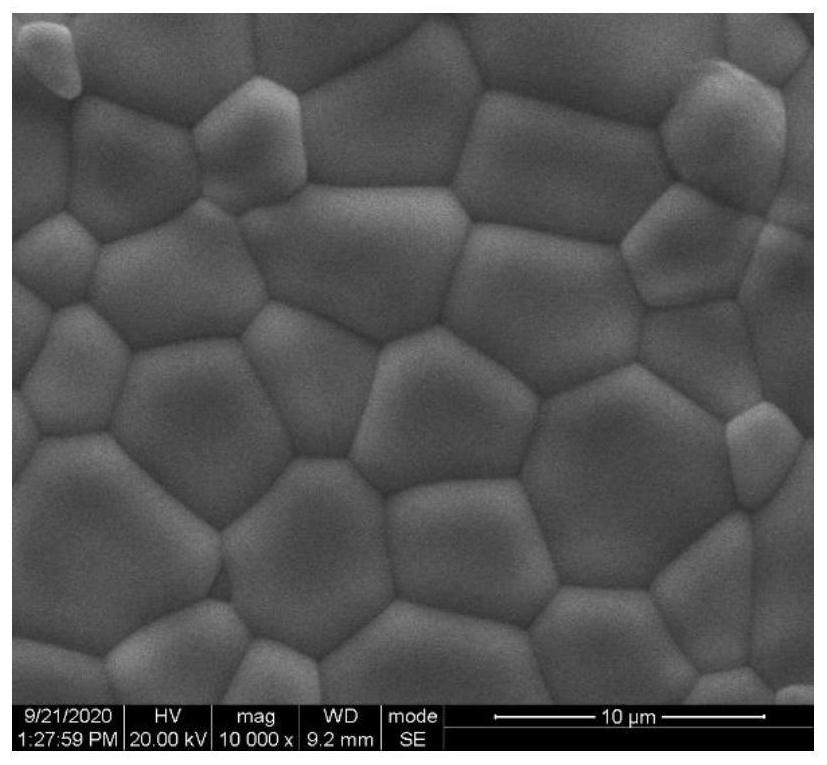Ultra-low loss yttrium aluminum garnet microwave dielectric ceramic material and preparation method thereof
A microwave dielectric ceramic, yttrium aluminum garnet technology, applied in ceramics, inorganic insulators and other directions, can solve the problems of low relative density, low Q×f value, high difficulty, etc., and achieve stable performance, low price, and improved performance. Effect
- Summary
- Abstract
- Description
- Claims
- Application Information
AI Technical Summary
Problems solved by technology
Method used
Image
Examples
Embodiment 1
[0037] Step 1: put Y 2 o 3 、Al 2 o 3 , MgO, SiO 2 、TiO 2 , prepare materials according to the mass ratio of 56.7%, 42.6%, 0.2%, 0.3%, 2.4%, 0.2% and 0.3% respectively;
[0038] Step 2: a ball mill; the obtained mixture is milled with alumina balls as the ball milling medium, and absolute ethanol is used as the solvent, and ground for 24 hours according to the weight ratio of mixture: balls: ethanol as 1:5:2, and finally obtained a well-mixed mixture;
[0039] Step 3: drying and sieving; the ball-milled mixture is dried at 70°C and passed through a 100-mesh sieve to obtain a dry powder;
[0040] Step 4: Pre-firing; put the dry powder obtained in Step 3 in an alumina crucible, and then pre-fire and keep it warm at 1100°C for 3 hours to obtain a sample briquette;
[0041] Step 5: Secondary ball milling; the calcined powder obtained in step 4 is ball milled for the second time, using alumina balls as the ball milling medium, and milling for 10 hours according to the mass rati...
Embodiment 2
[0047] Step 1: put Y 2 o 3 、Al 2 o 3 , Ga 2 o 3 , prepare materials according to the mass ratio of 56.9%, 42.6% and 0.5% respectively;
[0048] Step 2: a ball mill; use alumina balls as the ball milling medium, and grind for 24 hours according to the mass ratio of mixture: balls: alcohol to obtain a uniformly mixed ball mill;
[0049] Step 3: drying and sieving; drying the ball mill material obtained in step 2 at 70°C and passing through a 100-mesh sieve to obtain a dry powder;
[0050] Step 4: Pre-calcining; the dry powder obtained in Step 3 is placed in an alumina crucible, and pre-fired at 1300°C for 5 hours to obtain a pre-fired powder;
[0051] Step 5: Secondary ball milling; the calcined powder obtained in step 4 is ball milled for the second time, using alumina balls as the ball milling medium, and milling for 12 hours according to the mass ratio of powder: ball: alcohol of 1:3:2 Obtain a uniformly mixed secondary ball mill;
[0052] Step 6: drying and sieving; ...
Embodiment 3
[0057] Step 1: put Y 2 o 3 、Al 2 o 3 , Nb 2 o 5 , prepare materials according to the mass ratio of 54.9%, 42.9% and 2.2% respectively;
[0058] Step 2: a ball mill; use alumina balls as the ball milling medium, and grind for 20 hours according to the mass ratio of mixture: balls: alcohol of 1:7:2 to obtain a uniformly mixed ball mill;
[0059] Step 3: drying and sieving; drying the ball mill material obtained in step 2 at 70°C and passing through a 100-mesh sieve to obtain a dry powder;
[0060] Step 4: Pre-calcining; the dry powder obtained in Step 3 is placed in an alumina crucible, and pre-fired at 1200°C for 4 hours to obtain a pre-fired powder;
[0061] Step 5: Secondary ball milling; the calcined powder obtained in step 4 is ball milled for the second time, using alumina balls as the ball milling medium, and milling for 10 hours according to the mass ratio of powder: ball: alcohol of 1:5:1 Obtain a uniformly mixed secondary ball mill;
[0062] Step 6: drying and ...
PUM
| Property | Measurement | Unit |
|---|---|---|
| frequency temperature coefficient | aaaaa | aaaaa |
| resonant frequency temperature coefficient | aaaaa | aaaaa |
| relative permittivity | aaaaa | aaaaa |
Abstract
Description
Claims
Application Information
 Login to View More
Login to View More - R&D
- Intellectual Property
- Life Sciences
- Materials
- Tech Scout
- Unparalleled Data Quality
- Higher Quality Content
- 60% Fewer Hallucinations
Browse by: Latest US Patents, China's latest patents, Technical Efficacy Thesaurus, Application Domain, Technology Topic, Popular Technical Reports.
© 2025 PatSnap. All rights reserved.Legal|Privacy policy|Modern Slavery Act Transparency Statement|Sitemap|About US| Contact US: help@patsnap.com



